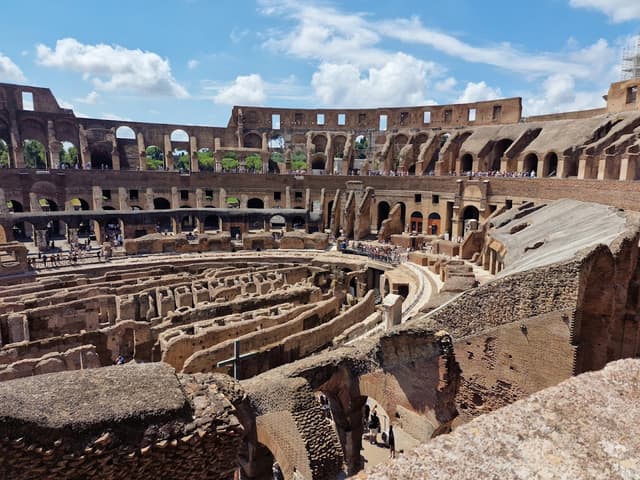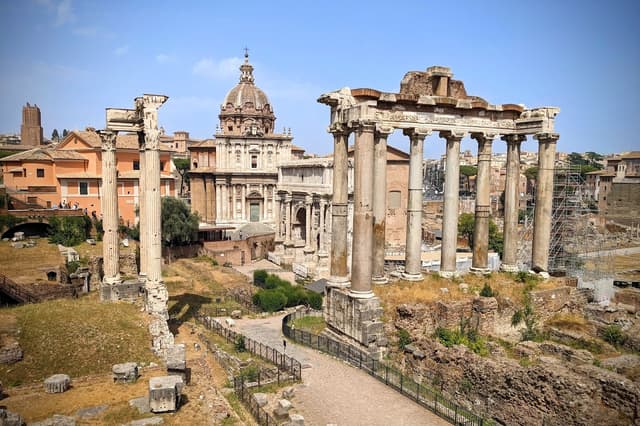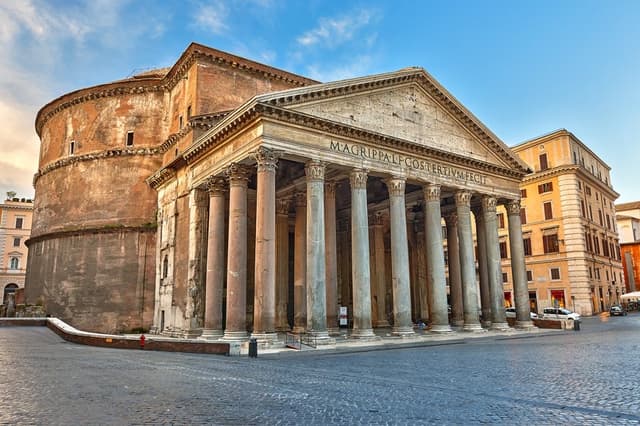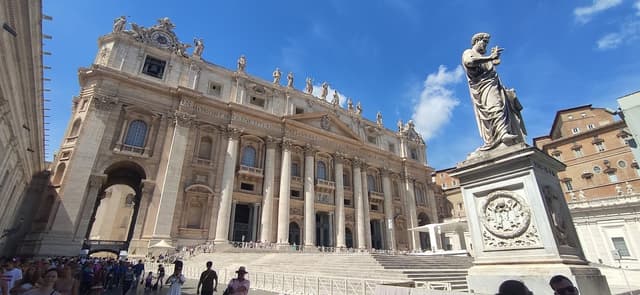Rome is a massive city, and having only one day in the city feels like a crime. However, one day is better than no time at all so here's a one-day itinerary for Rome!
Colosseum
Start your day with a visit to the Colosseum. This site books up quickly, so make sure you buy the tickets in advance. If you're too late, you can book tickets through tour companies. This will be more expensive but you're also only in Rome for one day!

Colosseum
@elizabethrickert
The Colosseum, also known as the Flavian Amphitheatre, is an iconic symbol of ancient Rome and one of the greatest architectural and engineering marvels of the ancient world. Built between 70 and 80 AD, this colossal structure was designed to host gladiatorial contests, public spectacles, and dramatic performances. With a capacity of up to 80,000 spectators, the Colosseum's grandeur is evident in its intricate system of vaults and arches, which allowed it to stand the test of time.
Today, visitors can explore this magnificent edifice through a variety of guided tours that provide insight into its history and architecture. The Colosseum is open year-round, with extended hours during peak seasons. It's highly recommended to book tickets in advance to avoid long queues, and consider purchasing a combined ticket that includes access to the Roman Forum and Palatine Hill for a comprehensive experience of Rome's ancient heritage. For those interested in deeper exploration, some tours offer access to restricted areas such as the underground chambers and the arena floor.

Details
Your ticket will include entry into the Roman Forum ruins. If you have time, definitely go. The entry line may be long, so you'll need to decide timing.

Roman Forum
@elizabethrickert
The Roman Forum, or Forum Romanum, was the vibrant center of ancient Rome, serving as the hub of public life, politics, and commerce. This sprawling complex of ruins includes remnants of grand temples, basilicas, and triumphal arches that once hosted political debates, legal proceedings, and religious ceremonies. Key highlights include the Temple of Saturn, the Arch of Septimius Severus, and the Rostra, from which orators addressed the masses.
Visitors to the Roman Forum can immerse themselves in the grandeur of Rome’s past by wandering through the evocative ruins and exploring the historical layers of this ancient civic space. The Forum is included in the combined ticket with the Colosseum and Palatine Hill, making it easy to explore all three key sites. To make the most of your visit, consider joining a guided tour that provides detailed historical context and brings the ruins to life. The Forum is open daily, with extended hours during peak tourist seasons. Booking tickets in advance is recommended to skip the lines and enjoy a more relaxed visit.

Details
Trevi Fountain
Next, you'll walk about 20 minutes to the Trevi Fountain. The Trevi Fountain is an 18th-Century fountain with a legend. The legend states that if you stand with your back to the fountain and toss a coin over your left shoulder, you have guaranteed a return trip to Rome.

Trevi Fountain
@elizabethrickert
The Trevi Fountain, or Fontana di Trevi, is one of Rome's most beloved landmarks and an exquisite example of Baroque artistry. Completed in 1762 by architect Nicola Salvi, the fountain is famed for its dramatic design featuring Neptune, the god of the sea, riding a chariot pulled by sea horses. The majestic water feature, which stands 26 meters high and 49 meters wide, is not only a masterpiece of sculpture and architecture but also a popular spot for visitors who follow the tradition of tossing a coin over their left shoulder to ensure a return to Rome.
Visitors can enjoy the fountain at any time, as it is illuminated beautifully at night and provides a picturesque setting throughout the day. To avoid the busiest times, it’s best to visit early in the morning or later in the evening. The fountain is located in the Trevi district, easily accessible by foot or public transportation. While there is no admission fee, it's a good idea to be mindful of the crowds and to respect the historical monument by not touching the water or climbing on the fountain.

Details
Pantheon
Travel 8 more minutes to the Pantheon. This is the best-preserved monument of ancient Rome. You must book in advance if you want to visit with an audio guide, a guided tour, or on a weekend. Otherwise, it is free entry and come as you can.

Pantheon
@elizabethrickert
The Pantheon, a stunning masterpiece of ancient Roman architecture, stands as a testament to the ingenuity of its creators. Completed around 126 AD during Emperor Hadrian’s reign, this remarkable structure was originally built as a temple to all the Roman gods. Its most striking feature is the vast dome, which remains the world’s largest unreinforced concrete dome to this day. The oculus at its center allows natural light to illuminate the interior, creating a breathtaking effect.
Visiting the Pantheon offers a chance to marvel at its architectural brilliance up close. Located in the heart of Rome, the Pantheon is easily accessible and is open to the public daily. Admission is free, though donations are encouraged. It is advisable to visit early in the day or later in the afternoon to avoid peak crowds. Audio guides and guided tours are available for a deeper understanding of the building’s history and significance. Additionally, the Pantheon’s central location makes it a perfect starting point for exploring Rome’s nearby historic sites.

Details
Vatican City
Half an hour further, you'll reach Vatican City. This independent nation is in the heart of Rome and home to the Pope. You can tour St. Peter's Basilica, the Sistine Chapel and the Vatican Museums. Many ticket options exist, so check out their website to see what suits your needs best. I do recommend that you book this in advance. The line for day of tickets is often down the street.

Vatican City
@elizabethrickert
Vatican City, the smallest independent state in the world, is a spiritual and cultural treasure trove nestled within Rome. As the epicenter of the Roman Catholic Church, it is home to some of the world's most renowned artistic and religious treasures. The Vatican's crown jewel is St. Peter's Basilica, an architectural marvel featuring Michelangelo's Pietà and an awe-inspiring dome. The Vatican Museums, renowned for their extensive art collection and the Sistine Chapel, where Michelangelo's famous ceiling frescoes are housed, attract millions of visitors each year.
Visitors to Vatican City can explore these incredible sites by purchasing tickets online in advance to avoid long lines. The Vatican Museums and Sistine Chapel require a reservation for entry, which can be made through the official Vatican Museums website or various authorized tour operators. St. Peter's Basilica is open to the public, though security checks and modest dress codes are enforced. For a more immersive experience, consider joining a guided tour that offers skip-the-line access and detailed historical insights. Additionally, if you plan to visit on a Wednesday, you might have the chance to attend the Pope’s General Audience, held in St. Peter's Square, where you can experience a unique aspect of Vatican City’s spiritual life.

Details
If you're not rushing back, stop in one of the plazas for wine and delicious food. Rome has a great food scene and should be appreciated as much as possible!
If you've enjoyed this guide, please share, write a review, or leave a tip! Thank you!
* * *





